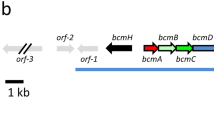Summary
The antimutagenic activity, i.e. the capacity to decrease the spontaneous mutation rate, of actinomycin and basic fuchsine was investigated. It was found that the minimal requirement for the antimutagenic activity of compounds forming complexes with DNA is their binding to the polynucleotides rather than their stabilizing them against thermal denaturation. It is proposed that these antimutagens act through an inhibition of the exonucleolytic removal of bases from DNA during transcription.
Similar content being viewed by others

References
Freifelder, D., P. F. Davidson, and E. P. Geiduscheck: Damage by visible light to the acridine orange DNA-complex. Biophys. J. 1, 389 (1961).
Johnson, H. G., and M. K. Bach: Apparent suppression of mutation rate in bacteria by spermine. Nature (Lond.) 208, 408–409 (1964).
Kirk, J. M.: The mode of action of actinomycin D. Biochem. biophys. Acta (Amst.) 42, 167 (1960).
Magni, G. E., and R. C. V. Borstel: Different rates of spontaneous mutations during mitosis and meiosis in yeast. Genetics 47, 1097–1108 (1962).
—, R. C. v. Borstel, and P. Sora: Mutagenic activity during meiosis and antimutagenic activity during mitosis by 5-aminoacridine in yeast. Mutation Res. 1, 227–230 (1964).
Pauling, C., and P. Hanawalt: Non-conservative DNA replication in bacteria after thymine starvation. Proc. nat. Acad. Sci. (Wash.) 54, 1728 (1965).
Puglisi, P. P.: Mutagenic and antimutagenic effects of acridinium salts in yeast. Mutation Res. 4, 289–294 (1967).
Reich, F.: Actinomycin correlation of structure and function of its complexes with purines and DNA. Science 143, 684–686 (1964).
Riva, S. C.: Interactions of methylated acridines with DNA. Biochem. biophys. Res. Commun. 23, 606–611 (1966).
Sevag, M. G., and W. T. Drabble: Prevention of the antibiotic and sulfamide resistance by atabrine. Antimicrobial Agents and Chemotherapy 410–414 (1964).
Slotnick, I. J.: Mechanism of action of actinomycin D in microbiological systems. Ann. N.Y. Acad. Sci. 89, art. 2, 342 (1960).
Sourkey, J. T., and A. D'Iorio: Methabolic inhibitors (R. M. Ocster and H. J. Questel, eds), vol. II, p. 79. New York: Academic Press 1963.
Stewart, C. R.: Mutagenesis by acridine yellow in Bacillus subtilis. Genetics 59, 23–31 (1968).
Webb, R. B., and H. E. Kubitschek: Mutagenic and antimutagenic effect of acridine orange in Escherichia Coli. Biochem. biophys. Res. Commun. 13, 90–94 (1963).
Zeller, F. A.: The enzymes (P. D. Boyer, H. A. Lardy, and K. Myrback, eds.), vol. VIII, p. 313. New York: Academic Press 1963.
Author information
Authors and Affiliations
Additional information
Communicated by E. Witkin
Rights and permissions
About this article
Cite this article
Puglisi, P.P. Antimutagenic activity of actinomycin D and basic fuchsine in Saccharomyces cerevisiae . Molec. Gen. Genet. 103, 248–252 (1968). https://doi.org/10.1007/BF00273695
Received:
Issue Date:
DOI: https://doi.org/10.1007/BF00273695



